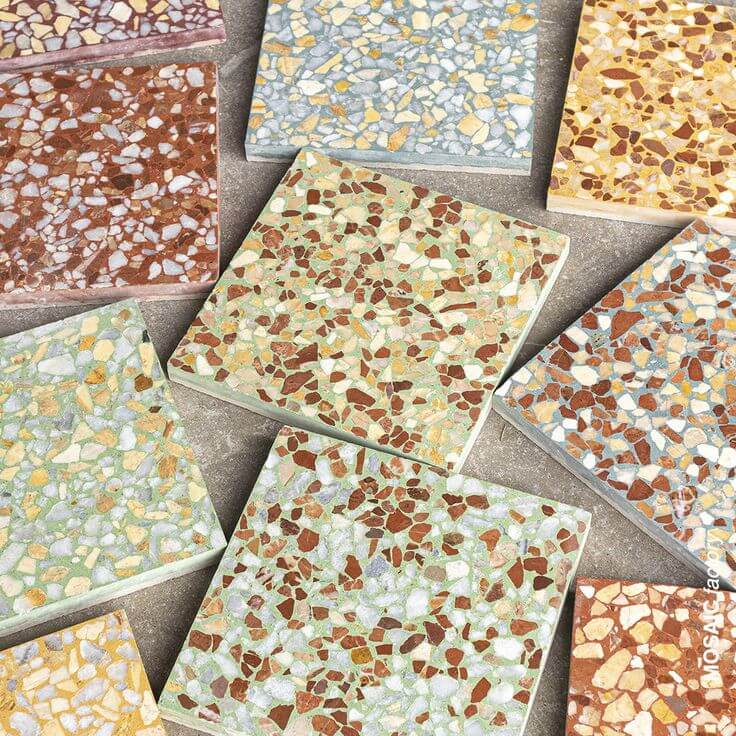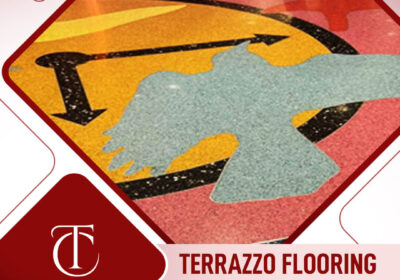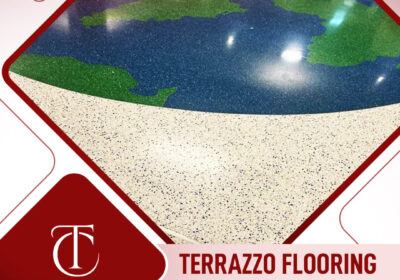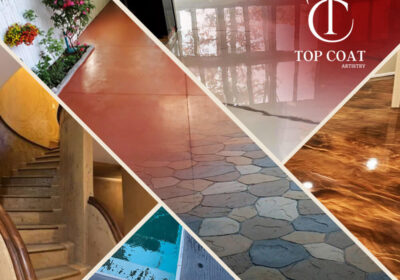Epoxy Terrazzo vs Cement Terrazzo: Differences, Benefits, Costs

Epoxy Terrazzo vs Cement Terrazzo: Differences, Benefits, Costs
Introduction: When it comes to flooring materials, terrazzo is a timeless choice that combines beauty, durability, and design versatility. Terrazzo flooring is made by combining marble, quartz, granite, or glass chips with either an epoxy or cement-based binder. However, the two types of terrazzo—epoxy terrazzo and cement terrazzo—have distinct properties, advantages, and ideal uses. In this article, we will explore the key differences between these two types of terrazzo, how they are used, and which one might be the best choice for your project, taking into consideration cost, maintenance, durability, and design flexibility.
What is Epoxy Terrazzo?
Epoxy terrazzo is a modern and highly durable type of terrazzo that uses an epoxy resin as the binder to hold together the aggregate chips, such as marble, granite, or glass. Introduced in the 1970s, epoxy terrazzo revolutionized the terrazzo industry by offering a more flexible, cost-effective, and versatile alternative to traditional cement terrazzo. The most notable feature of epoxy terrazzo is its ability to create seamless, colorful, and highly customizable designs.
One of the key advantages of epoxy terrazzo is its resilience. Epoxy is highly resistant to surface cracks and is better suited for areas with heavy foot traffic. It is also more resistant to stains and chemicals compared to cement terrazzo, making it a great option for interior spaces such as lobbies, hospitals, schools, and retail stores. Furthermore, epoxy terrazzo is lighter than its cement counterpart, making it an excellent option for multi-story buildings and spaces where weight is a concern.
Benefits of Epoxy Terrazzo:
- Durability: Resistant to cracks and stains.
- Design Flexibility: Allows for intricate designs and patterns due to its versatile nature.
- Low Maintenance: Epoxy terrazzo is easier to clean and maintain than cement terrazzo.
- Chemical Resistance: Ideal for environments that may be exposed to harsh chemicals.
- Lightweight: Makes it ideal for multi-story installations.
Drawbacks of Epoxy Terrazzo:
- Not suitable for outdoor use: Epoxy terrazzo is not ideal for outdoor applications as it can peel, fade, and degrade when exposed to UV rays and fluctuating weather conditions.
- Long-term exposure to UV light may cause fading: While it’s highly durable in indoor settings, long-term exposure to sunlight can cause the colors to fade over time.
What is Cement Terrazzo?
Cement terrazzo, also known as cementitious terrazzo, is the original form of terrazzo flooring. Unlike epoxy terrazzo, which uses a resin binder, cement terrazzo uses Portland cement as the binder to hold the aggregate chips together. Cement terrazzo is typically heavier and thicker than epoxy terrazzo, making it suitable for exterior and large-scale projects.
Cement terrazzo is commonly used in outdoor applications and renovation projects because of its superior weather resistance. It can handle exposure to extreme weather conditions, such as rain, sun, and freezing temperatures, without suffering significant degradation. Cement terrazzo also tends to be more affordable than epoxy terrazzo, but it requires a longer curing time and more labor-intensive installation.
Benefits of Cement Terrazzo:
- Outdoor Suitability: Best for exterior applications due to its resistance to weather and UV degradation.
- Heavy Duty: Suitable for large-scale and commercial applications.
- Cost-Effective: Generally more affordable in terms of material cost compared to epoxy terrazzo.
- Weather Resistance: Can withstand exposure to harsh weather conditions.
Drawbacks of Cement Terrazzo:
- Heavier and thicker: Requires a more solid substructure, making it less suitable for multi-story buildings.
- Labor-Intensive Installation: The installation process is more complicated and requires skilled professionals.
- Higher Maintenance: Needs more frequent upkeep and maintenance compared to epoxy terrazzo.
Key Differences Between Epoxy Terrazzo and Cement Terrazzo
1. Binder: The most fundamental difference between epoxy terrazzo and cement terrazzo is the binder used. Epoxy terrazzo uses an epoxy resin, which is more flexible and provides better design versatility. Cement terrazzo, on the other hand, uses Portland cement, which results in a more rigid and heavy material, better suited for outdoor applications.
2. Durability: Epoxy terrazzo is generally more durable than cement terrazzo, particularly in high-traffic indoor areas. It is resistant to cracking and can handle wear and tear more effectively. In contrast, cement terrazzo, while durable, is more prone to surface cracks and damage, especially in areas that experience heavy moisture or extreme weather conditions.
3. Design Flexibility: Epoxy terrazzo offers superior design flexibility. Because it is a resin-based product, it can be poured in place to create seamless floors and intricate patterns, colors, and shapes. Cement terrazzo, though highly customizable, is generally less flexible in design and requires more effort to create unique patterns.
4. Cost: The cost of epoxy terrazzo generally ranges from $25 to $90 per square foot, depending on the complexity of the design and the quality of the materials used. Cement terrazzo, on the other hand, is typically cheaper, ranging from $15 to $50 per square foot. However, cement terrazzo requires more labor-intensive installation and may incur additional costs over time due to maintenance.
5. Maintenance: Epoxy terrazzo is generally easier to maintain than cement terrazzo. It is resistant to stains and can be cleaned using standard cleaning materials. Cement terrazzo requires more effort to maintain, as it may need sealing to prevent stains and deterioration, particularly in outdoor or high-moisture environments.
Terrazzo Flooring Costs
The cost of terrazzo flooring can vary significantly based on several factors, including the type of terrazzo, design complexity, installation method, and location. Typically, epoxy terrazzo is more expensive than cement terrazzo due to the materials and installation process. On average, epoxy terrazzo can cost anywhere between $25 and $90 per square foot, while cement terrazzo ranges from $15 to $50 per square foot.
For larger projects, poured-in-place epoxy terrazzo tends to be more cost-effective, as it eliminates the need for tiles, making it a better choice for expansive areas. On the other hand, terrazzo tiles may be more appropriate for smaller spaces or where a specific design is desired.
Sealing and Maintenance of Terrazzo Floors
Both epoxy and cement terrazzo floors require some level of maintenance to keep them looking their best. For epoxy terrazzo, it’s recommended to apply a sealer immediately following the final polishing. This will protect the surface from stains, spills, and wear. Regular cleaning with a soft mop and mild detergent is typically sufficient for maintaining the floor’s appearance.
Cement terrazzo, being more porous, may require more frequent sealing and care to prevent water damage and stains. It’s important to clean up spills immediately to prevent them from soaking into the surface and causing permanent staining.
How to Restore Terrazzo Floors
The most effective way to restore terrazzo floors is through diamond polishing, a process that uses specialized diamond pads to grind the floor to a smooth, shiny finish. Diamond polishing is effective for both epoxy and cement terrazzo, and it can last between 8 to 10 years under normal use without needing a full restoration. After this time, the floor may need a light re-polishing with finer grits.
Conclusion
When deciding between epoxy terrazzo and cement terrazzo, it’s essential to consider the specific needs of your project. Epoxy terrazzo offers greater design flexibility, easier maintenance, and better indoor performance, but it is not suitable for outdoor use. On the other hand, cement terrazzo is perfect for outdoor applications and larger projects, offering durability and weather resistance but requiring more maintenance.
Contact Us for Your Terrazzo Flooring Project
Looking to upgrade your floors with epoxy or cement terrazzo? We specialize in providing high-quality terrazzo flooring solutions tailored to your needs. Whether you’re looking for intricate designs for an interior space or durable outdoor applications, we have the expertise to bring your vision to life.
📍 Location: Serving New Jersey and surrounding areas
📞 Call Now: +1 (201) 315-2633
📧 Email: sales@yourcompanyname.com
Let us help you create stunning, durable terrazzo floors that will last for years!
Meta Keywords:
Epoxy terrazzo, cement terrazzo, terrazzo flooring cost, terrazzo floor installation, terrazzo maintenance, terrazzo restoration, epoxy vs cement terrazzo, terrazzo tile vs poured-in-place, terrazzo flooring benefits, cement terrazzo design, epoxy terrazzo design, terrazzo restoration guide, terrazzo cost per square foot, terrazzo cleaning, terrazzo sealing, terrazzo crack resistance, terrazzo outdoor use, terrazzo design flexibility, terrazzo cost comparison, terrazzo installation tips, terrazzo flooring for homes



